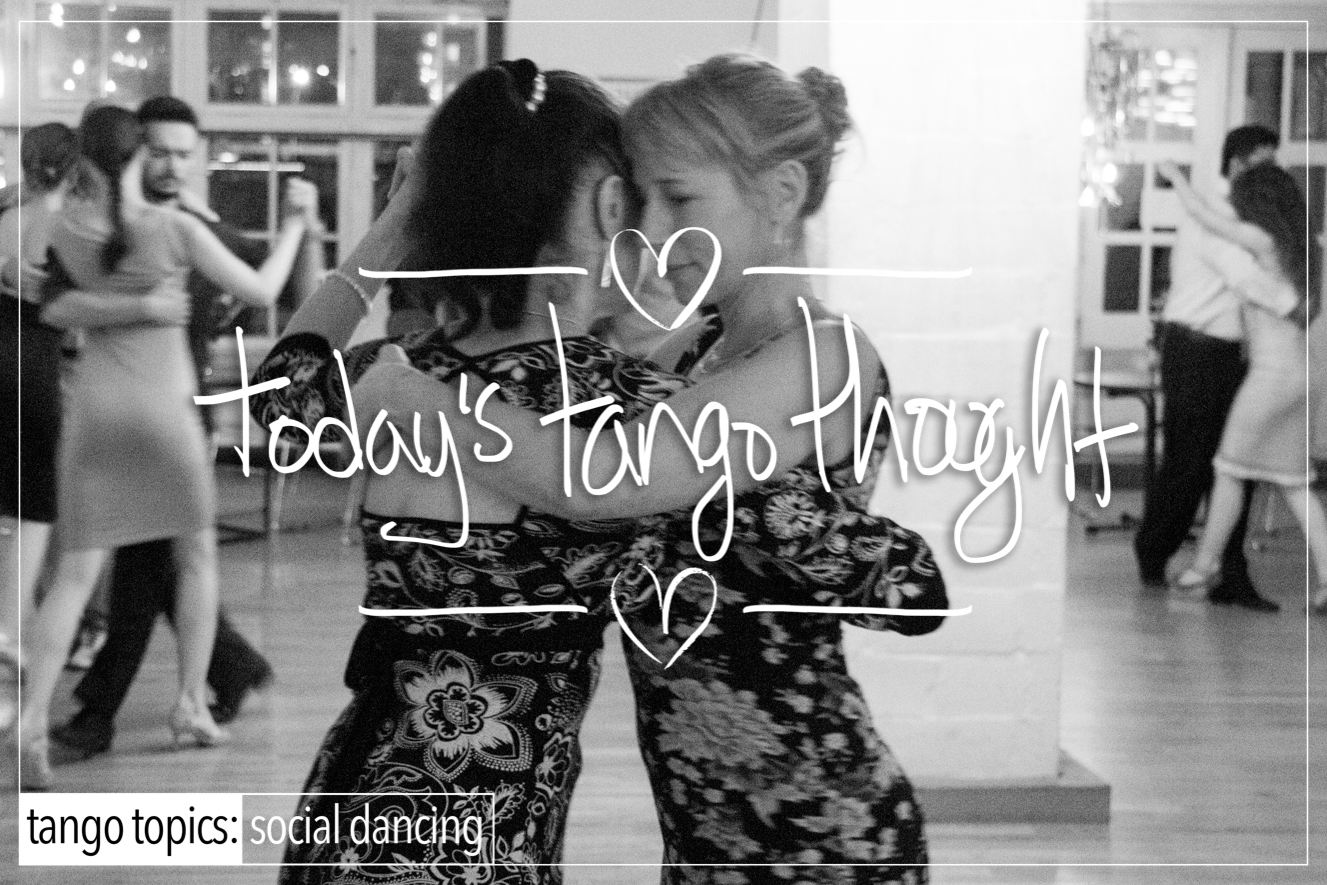The Practice of Cabeceo. Typically the word “Cabeceo” is generally defined as a slight nod of the head, sometimes done in concert with a direct or piercing eye stare, usually initiated by the Lead, to indicate to their intended Follower, that said Lead would like to dance with that particular Follower. The Follower’s response is either a reciprocating head nod to indicate their acceptance of the Cabeceo, or a head shake to indicate a ‘No’ they’re not interested, or it may be deliberately ignored altogether! This is the preferred method, and practice, to ask for, and accept a dance at most Milongas in the world, and specifically in Buenos Aires, at certain Milongas.
In this typical scenario above of the definition, it is rather clear that the Lead that is asking for dance is decidedly ‘Male’, and the target recipient is decidedly ‘Female’. Ok, it’s not clear, but for most people reading this quick definition, this gender perception is the thought that came to their minds.
However, what happens in the case where gender isn’t a factor ? What happens when you have two same-sex genders dancing together ? How do they negotiate the asking and acceptance of a dance together ? Who does what ? The typical gender obvious ‘clarity’ no longer applies! How do you manage this idea ? Are there different rules for engagement in a gender unbiased situation that you may not be aware of ?
Enter The Non-Gender Cabeceo!
Let’s get a few things out of the way first. This topic puts aside your disdain or desire to dance with the same sex. It puts aside the codigos of doing such a thing at certain Milongas. For the moment, if you haven’t been living under a rock, then you’ll have noticed at Milongas that more and more women are Leading and not necessarily Following, and more and more men are spending time learning to and actually Following on a regular basis! So the question arises, how do these people negotiate a dance with each other ? A Non-Gender Cabeceo.
The typical way that most Leads (the person, not the action – that’s a lowercase ‘l’) discern that their intended target is an available dance partner is by looking at their gender. However in this instance that obvious clue no longer applies. Nor do their clothes, nor do their shoes! Typically we further confirm our understanding of availability and subsequently the role that they dance, is also by the clothes that someone wears or the shoes that they have on. However, in this case, those clues are no longer present or more importantly they no longer apply. While it is entirely true that one can dance the role of the Lead in heels, it’s a little challenging but can be done with aplomb! The intended target may be wearing ‘flats’! So if all the normal cues are missing, how do you discern availability and/or role ? Again…The Non-Gender Cabeceo!
What is a ’Non-Gender Cabeceo’ ? A Non-Gender Cabeceo works exactly the same way that a Gendered Cabeceo works. There’s nothing special or different about it. The practice is exactly the same regardless of Gender, or at least it should be. If same-sex dancing, or role fluidity, is permitted at Milongas, Marathons, and Encuentros, then the same rules apply in a Gendered Cabeceo. And truthfully it is even more accepted when gender isn’t a factor, role is a factor! But that’s down the page. However, in a Non-Gender Cabeceo it is generally understood that the one that ‘asked’ or initiated the Cabeceo is asking to ‘Lead’. This isn’t always the case but usually. Because we also have the idea or practice of Mirada which can also be fluid here as well, and again, the same rules apply! At the same time in both cases of Cabeceo and Mirada we adhere to the same ideals and principles as before. Nothing has changed. While the determining factor here is an understanding that the person that asked is generally going to lead (see ? small ‘l’ for the action). This is a Non-Gendered Cabeceo!
So the next question comes up, how do you determine ‘Role’, in this instance ? Actually, that one is really easy. There’s a place for that and it requires one more step than the usual process. It is a necessary step actually. It comes at the beginning of the dance, as you’re stepping on the floor, after the acceptance of the Cabeceo. We ask the following question: “Do you want to lead or follow ?”. This is how we negotiate Cabeceo/Mirada, and at the same time discern role. 🙂
The Tango Topics Opinion: Two thoughts need to be addressed as it relates to this topic that doesn’t speak to logic or reason. These things exist in the tango world, so take in the information. What follows is are not judgments, admonishments, or endorsements, these things are present:
1.) There are people that view the idea of Same-Sex dancing as an abomination, for a variety of reasons, not the least of which is that it’s just ‘wrong’. In their minds, Tango is all about a Man and a Woman dancing. That’s it. That’s all there is, and that’s all that there will ever be. They can’t see the dance any other way. So watching two men dance together, is nothing short of “What’s the point ?”. And trying to explain to these people that there is a reason and definitive purpose that is outside the sexual is almost … almost, lost on them. Until you remind them of the historical fact: It wasn’t that long ago that Men used to dance with other men in order to learn the other role and they weren’t allowed to progress to actually leading until they had mastered the Follower’s role! Mind you, this isn’t just a guy thing, it’s also a woman thing as well. Women also have this bias as well. And sometimes it’s gender-based, and sometimes it’s entirely based on preference. That they can’t possibly see the benefit of dancing with a Female Lead. They can’t possibly get anything from it. This is a general perception.
2.) Secondly, as time has gone on and the idea of role swapping and gender fluidity occurs more and more frequently in our collective societies that Tango is slowly moving along with these ideas, ever so slowly.
In case it wasn’t clear, this site is a very active advocate of role swapping as a means to an end! While you may never dance the opposite role (which would be a shame on multiple levels) publicly, privately you can and should practice both roles and pursue them with all due diligence if for no other reason than a simple axiom, “Never ask someone to do a job that you haven’t done yourself”.
Most people can benefit from having their experience augmented by leading or following a dancer like themselves. It is an eye-opening and very humbling experience, assuming they’re able to hear the information that is being shared back to them. How’s that ? Imagine following a Lead who uses their arms, their hands, to force them to do X, Y, and Z. More than likely they’ll get the hint that they don’t like that. Imagine leading a Follower that anticipates, or auto-completes an Ocho with being led to do so, or the auto-cross follower, or the auto boleo every other step where there’s space to do it, or hangs, or uses their hands and arms for stabilization, but doesn’t know it. This experience can be very illuminating, a window on your experience of dancing that can for all intent change how you perceive the dance and how you respond to the dance, and more than likely will force you to revisit every preconceived notion about how YOU dance! And that is the beginning of a change in you, right there. But there’s a flaw in this progression of ideas, it’s that in order for this stuff to work, you a.) must to be ready to hear it. and you must b.) have someone that can tell you that you’re generating these things as feedback! Without that feedback loop, there’s every possibility that you’ll think you’re doing just fine.
This experience is a perfect ‘mirror’, if you will, for which there is no other way to get this information. Because while feedback from someone else is insanely important, as is the act and practice of social dancing, as is class time, workshop time, and private lesson time, as well as solo practice time, the mere fact that you are actively pursuing both roles with equal and due diligence speaks volumes about you as a dancer and your level of commitment, not to mention it gives you a leg (no pun intended) on to your ‘perceived’ competition. So as far as a Non-Gender Cabeceo applies to Role-based dancing, it just creates the opportunity for this stuff to happen for you to learn, to grow, and to change as a dancer.
Let’s be clear about one thing, in the end, no one is forcing you to dance the other role. No one is saying, you ‘must’ dance the other role in order to be a better dancer. And as far as the Non-Gender Cabeceo is concerned, no one is forcing you to engage in the practice. Quite the opposite…which is to say, go with the flow and do what moves you.
However, in Tango Topics’ experience, the axiom above is the god’s honest truth! YMMV but the students of Tango Topics, and in specific the Intensive Level students that have passed through the Intensive Process have a completely different Tango experience. One that for all intent and purpose took them far less time to do than the typical dancer, and at the same time given them greater kinesthetic, physiological, and psychological insights that allowed them to, quite factually, leap-frog over their contemporaries to come out the other side as desirable social dancers on multiple levels.











